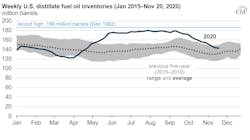According to the U.S. Energy Information Administration’s Weekly Petroleum Status Report, for the week ending Nov. 13, U.S. distillate inventories fell to 143 million barrels, back within their previous five-year (2015–19) range for the first time since May 8.
U.S. distillate inventories reached 180 million barrels in late July, only 3% less than in December 1982, the largest U.S. inventory in EIA’s data, which go back to 1982.
Distillate inventories started the year near the bottom of the five-year range and briefly fell lower than the range in March and April. Distillate inventories then increased rapidly as the U.S. economy responded to COVID-19, and from late May through mid-September, inventories remained higher than 174 million barrels. Since mid-September, inventories have been declining and are once again within the five-year range.
U.S. demand for distillate has been generally increasing since it reached an annual low in May (based on the rolling four-week average). The increasing demand for distillate fuel has contributed to the recent inventory decline. As of the week ending Nov. 20, weekly EIA data indicate that distillate demand reached 4.2 million barrels per day (b/d), similar to the previous five-year average for this time of year.
In addition to rising demand from the trucking and railroad industries, refineries have been making less distillate fuel. Gross inputs into refineries measured 14.2 million b/d as of Nov. 20, or 14% lower than the previous five-year average for this time of year. Distillate yields, or the ratio of distillate fuel production to refinery inputs, have fallen since reaching a record high of 38% in April, and more recently, it measured 31% in the week ending Nov. 20, which is much closer to the previous five-year average for this time of year.
